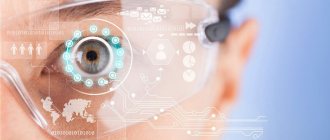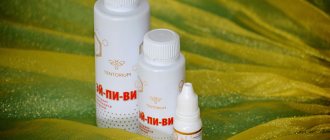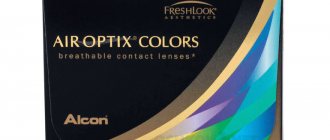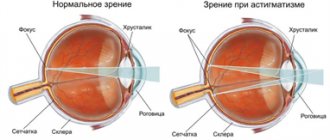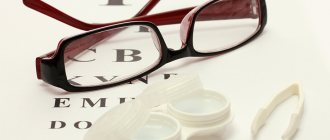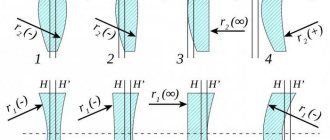Correcting myopia using lenses is a worthy competition to wearing glasses. The use of contact products is convenient and comfortable, and is highly appreciated by many patients with myopia. Lenses for myopia are used in the presence of certain medical indications:
- myopic astigmatism;
- combinations of myopia with certain ophthalmological disorders (keratoconus, amblyopia, strabismus).
Contact optics are recommended for people whose profession or lifestyle makes wearing glasses undesirable (this includes builders, doctors, athletes). These products are also addressed to people who do not want to use spectacle correction for aesthetic reasons.
The list of contraindications to the use of lenses includes xerophthalmia, which causes dryness of the cornea and conjunctiva, impaired lacrimation, inflammation of the ocular structures, and lens displacement. The method is not recommended for asthmatics, patients with vasomotor rhinitis and other allergic pathologies.
Myopia
The projection of what is seen during myopia is displayed not on the retina, but on the plane in front of it. At the same time, a person sees well at a close distance, but distant objects have blurred contours. Constant staring leads to headaches and fatigue.
We recommend reading: Low myopia
Moderate myopia
High myopia
Myopia is characterized by 3 stages:
- Up to 3 diopters.
- From 3.25 to 6 diopters.
- From 6 diopters.
For this vision defect, optics with negative diopters are used. By using lenses at the initial stage, you can completely restore your vision.
What other lenses are used for myopia?
Biconcave diverging lenses and their varieties are used in spectacle correction. If contact optics is selected, then the choice is between spherical and aspherical ophthalmic products. The method of correcting myopia and the mode of wearing optics depend on the type of refractive error and its degree. There are three degrees of myopia:
1. Light - up to −3 diopters. The patient most of the time manages without correction means. Only very distant objects appear blurry. Usually, with this degree of myopia, drivers use lenses when they are driving. 2. Average - from −3 to −5-6D. The distance of good vision is noticeably reduced. Glasses are required to be worn almost always. They are removed before reading or working at the computer. However, watching TV without optics is already problematic. Children with this degree of myopia wear glasses in class to clearly see what is written on the blackboard. 3. High - from −6D. You even have to read using lenses. There are very severe forms of myopia with an index of −20 and −25D. They are the most difficult to correct.
Glasses for myopia are usually prescribed for mild to moderate myopia. They can be corrected with conventional biconcave lenses or other diverging optical products - plano-concave, convex-concave. Such glasses cannot cope with high myopia. It is not always possible to get used to them. They have very thick glass, and therefore look unaesthetic. In addition, for many patients, wearing such optics causes:
- fatigue;
- headaches and dizziness;
- rapid eye fatigue;
- lacrimation.
In such cases, contact optics are used. We will not talk about all the advantages of this correction method. We only note that contact lenses are better tolerated, especially with severe myopia. However, this type of ophthalmic products must be selected correctly.
Lens parameters
Before you start using contact lenses, you must consult with an ophthalmologist, who, during examination, will determine the degree of myopathy and examine the fundus of the eye. Lenses made of hard material and night lenses have a therapeutic effect, soft ones are used for correction. To reduce dryness of the eye mucosa, optics with a moisture content of 55% or more are used.
When selecting lenses, the radius of curvature is taken into account, which is determined by the curvature of the human cornea. As a rule, this parameter is 8.6 mm, but taking into account the individual structure of the eye, the figure can vary within 8.3 mm or 8.8 mm. If you choose the right radius of curvature, the optics will not slide across the surface of the eye when blinking or moving.
Otherwise, injuries will occur and irritation will occur.
Flaws
It is worth noting that not everyone is allowed to wear contact lenses, and they may not be suitable for everyone. A foreign body in the eye may not be accepted by the body, which can lead to inflammation or excessive tearing.
The material from which the lenses are made is quite thin, so they are easy to tear. If they were prescribed to a child during adolescence, difficulties may arise with correct insertion. Due to the resulting inflammatory processes in the mucous membranes, it is not recommended to wear them during colds, since the release of protein secretions leaves tears on them that cannot be washed off.
Model overview
To correct myopia, they produce models that need to be changed every day, and optics for scheduled replacement with a wear period of 14 days or more. The use of CL has no age restrictions. They produce optics to improve vision in cases of myopathy with astigmatism, as well as in cases of myopia with simultaneous farsightedness.
1-Day Moist Acuvue
Daily lenses with a moisture content of 58%, acid permeability of 33.3%. The material does not cause an allergic reaction and is protected from ultraviolet rays. Price per package - from 1220 rubles.
1-Day Acuvue TruEye
Oxygen permeability - 118, moisture content - 46%. The optics are protected from ultraviolet rays and relieve fatigue when using a PC. Packaging costs 1450 rubles.
Recommended reading: 1-Day Acuvue TruEye
Proclear 1 Day Cooper Vision
It is characterized by a moisture content of 60%, an oxygen throughput of 28, and a diameter of 14.2 mm. One-day products costing from 1300 rubles.
Biotrue One Day Bausch+Lomb
One-day optics are used for myopia up to - 9 diopters. CL are characterized by protection from ultraviolet rays, high moisture content - up to 95%, oxygen permeability - 42.
In hot weather or strong winds, the mucous membrane of the eyes does not dry out. Recommended to wear if you are prone to allergies. Price per package - from 1150 rubles.
Dailies Total 1 Alcon
The lenses have almost 100% moisture content, oxygen permeability - 156. The smooth surface of the material allows you to avoid discomfort when blinking. Designed to be worn for up to 16 hours. Cost - from 1790 rubles.
Air Optix for Astigmatism Alcon
Designed to be worn for 7 days for myopia with astigmatism. The optics have protective properties against protein and lipid deposits. Oxygen permeability - 138, moisture content - 33%, lens diameter - 14.5 mm. Price - from 1090 rub.
Acuvue Oasys for Astigmatism
Used for myopia with astigmatism. The optics are characterized by a moisture content of 38% and an oxygen throughput of 129. Designed for use for 2 weeks, they must be removed during sleep.
The lenses are comfortable to wear and have protection from ultraviolet rays. Price - from 1290 rub.
Recommended reading: Acuvue Oasys
Biofinity Toric Cooper Vision
The products are used for 30 days for astigmatism; they must be removed during sleep. They are characterized by moisture content - 48%, oxygen permeability - 116. Cost - from 1660 rubles.
1-Day Acuvue Moist Multifocal
The multifocal type of optics is characterized by an oxygen throughput of 28 and a moisture content of 58%. They do not require constant care; at the end of the day they are removed or left for day 2, but then thrown away after the end of the day.
Air Optix Aqua Multifocal Alcon
Use for daily wear for 30 days. Oxygen throughput - 138, moisture content - 33%. The optics protect against lipid and protein deposits. Packaging costs 1150 rubles.
Biofinity Multifocal Cooper Vision
Lenses with a moisture content of 48% and an oxygen throughput of 160. Used for daily wear for 30 days. Packaging costs from 1820 rubles.
Choosing contact lenses after an eye test
Only an ophthalmologist can help with the choice of any corrective agents. To determine myopia and prescribe lenses, your doctor may use objective or subjective testing methods. Let's figure out what they are.
Objective methods
Some of the most common objective types of vision testing are skiascopy and refractometry.
- Skiascopy uses a thin flat mirror with an internal hole. A beam of light is directed through it onto the eye. By rotating the mirror surface, the pupil is displayed in red or black. It depends on where in the fundus of the eye there is a place that reflects light. The degree of myopia in the patient is determined by the change in color. And based on these results, the necessary lenses are already prescribed.
- Refractometry is a study that determines the speed of refraction (the refractive power of the eye). It is based on studying the position of a luminous mark that is reflected from the fundus of the eye.
Subjective methods
Thumbnail of Sivtsev’s table: click to enlarge
Subjective methods include testing techniques without special and precise equipment.
- Most often, special posters are used for this (Sivtsev’s test table, tables for checking color perception).
- In addition, to identify visual pathologies, small sets of spectacle glasses or phoropters are used - devices with an automated change of lenses in front of the eyes of the person being tested.
Having identified one or another degree of myopia (weak, moderate and severe), the ophthalmologist will draw conclusions and recommend a certain type of lenses based on the material, correction method, wearing period and moisture content.
Wearing Features
The best option for eye health is the use of daily lenses, which are contraindicated for longer wear. But their price is not affordable for everyone. Many people prefer optics with a long wear life.
Such correction products require careful care. And before each putting on, you must wash your hands with soap.
We recommend reading: How to use lenses correctly
It is strictly forbidden to sleep in any lenses, except for night ones. During the period of conjunctivitis, blepharitis and other eye diseases, you should not wear optics. When taking a diuretic, antiallergic drug and using vasodilating drops, the dryness of the skin and mucous membranes increases, so during this period it is important to use moisturizing drops.
To correct myopia, soft spherical contact lenses are used, which are selected by an ophthalmologist. It is necessary to buy products only from trusted companies and, when using them, carefully check the expiration date.
How to choose the right one
You should not resort to independent selection of contact lenses, since the damage caused to your own vision may be irreversible. At the initial appointment, the ophthalmologist will be able to determine the muscle tone in the eyes, measure intraocular pressure and visual acuity, and advise on how to choose lenses for correction. .
For opponents of glasses, contact lenses for myopia would be an ideal option, but there are contraindications for them:
- inflammatory processes;
- chronic eye allergies;
- xerophthalmia or dry cornea;
- glaucoma;
- change in the composition of tear fluid.
How to choose lenses to correct myopia step by step:
- To determine which lenses the patient needs, the ophthalmologist must first find out whether they have been worn before, then use a special table and a projector to check visual acuity.
- Carrying out computer diagnostics is the next step of the examination, in which an autorefractometer is used, which determines the type of pathology and stage of the disease.
- Correction of refractive balance, which may be different for the left and right eyes, so-called anisometropia.
- The study of the binocular system, the essence of which is to separate the fields of vision with lenses of different colors, polarized and green-red, will help you see close and far equally well.
- Next, you should choose eye lenses or glasses by selecting different options.
- At the last stage, the correction mode is selected.
Consumer Reviews
Valentina: I have been using Acuvue lenses for 6 years. I give preference to one-day optics. They do not rub or cause burning.
Vasily: For 3 years I have been wearing Bausch+Lomb vision correction products. Everything is fine - the lenses breathe, are quickly put on, and the price is affordable.
Nikolay: I use daily lenses from Cooper Vision. The solution in which the products are contained does not cause irritation upon contact with the mucous membrane and is comfortable to wear. After water procedures, the mucous membrane dries out, so you have to use drops.
At what age can you wear it?
There is no unanimous opinion among ophthalmologists about the age at which children can wear lenses, but most are inclined to believe that children 10 years of age can use them. It is important that the child can independently care for the lenses. Children are in some cases more particular about wearing eye devices than adults. One of the main criteria is the child’s willingness to wear them and follow the rules of hygiene.
At the age of less than 10 years, it is possible to prescribe means for correcting myopia to a child individually in each case, but difficulties may arise in observing the rules of hygiene and care.
Small children are most often prescribed one-day-old specimens, which they put on in the morning, and take off and throw away in the evening. The second option is scheduled replacement contact lenses for a period of 1 month (used much less frequently). Properly selected one-day options are considered the most comfortable and safe for the child.
Answering the question why people prefer lenses to glasses, we can confirm the fact that a person feels more comfortable and confident in them, and their vision is corrected and treated. But it is worth remembering that the patient must keep his hands clean, do not rub his eyes and use drops to moisturize.
Useful video
Lenses are effective means of vision correction. To choose the right optics, you need to take into account the purpose, rules of use, and diagnosis.
Author's rating
Author of the article
Alexandrova O.M.
Articles written
2031
about the author
Was the article helpful?
Rate the material on a five-point scale!
( 1 ratings, average: 5.00 out of 5)
If you have any questions or want to share your opinion or experience, write a comment below.
Spherical and aspherical lenses for myopia
Even with 100% vision, spherical aberrations can occur - lateral distortions that appear when a beam of light passes through the optical structures of the eye. The human eyeball is a refractive system that includes the lens and cornea. They take a major part in the refraction of light rays. These optical media are characterized by imperfection. Their shape is not always ideal. Spectacle and contact lenses have the same feature.
Imperfections of the optical system of the eye include aberrations of lower and higher order. The first is myopia. Such a defect is compensated for, as mentioned earlier, by diverging lenses. However, they also have their own edge aberrations, since they are also imperfect. Light rays passing through scattering spherical optical products are not collected equally on the retina, but form a slight scattering. Even with complete correction of myopia, distortions may occur. They become especially noticeable in glasses when looking sideways. It was possible to get rid of this drawback by creating lenses with an aspherical surface.


